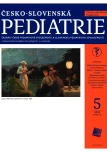-
Medical journals
- Career
New therapies in cystic fibrosis
Authors: Doušová Tereza
Authors‘ workplace: Pediatrická klinika ; Univerzita Karlova a FN Motol ; Praha ; 2. lékařská fakulta
Published in: Čes-slov Pediat 2023; 78 (5): 254-257.
Category:
doi: https://doi.org/10.55095/CSPediatrie2023/042Overview
Cystic fibrosis (CF) is the most common life-shortening genetic disease. It affects approximately 100,000 people worlwide. The disease is caused by bi-allelic patogenic variants in the gene encoding the CFTR (Cystic Fibrosis Conductance Regulator) protein, which plays a major role in ion transport across the apical membrane of the epithelial cells. Until recently, treatment of this disease was solely symptomatic. Causal therapy targeting molecular defect of CFTR protein has been available since 2012, when first therapeutic agent was registered. Currently, there are four CFTR modulators available and all together they can work in up to 90 % of all patients with CF. Determining parameter of the respective treatment is the patient’s genotype.
Keywords:
Cystic fibrosis – causal therapy – CFTR modulators
Sources
1. Amaral MD. Novel personalized therapies for cystic fibrosis: Treating the basic defect in all patients. J Intern Med 2015. https://doi.org/10.1111/joim.12314
2. A ndersen DH. Cystic fibrosis of the pancreas and its relation to celiac disease. Am J Dis Child 1938; 56 : 344.
3. Foundation CF. Cystic Fibrosis Foundation Patient Registry 2018 Annual Data Report. 2018.
4. T rust CF. UK CF Registry 2016 : 1–6.
5. Boeck K De, Amaral MD. Rapid review progress in therapies for cystic fi brosis. Lancet Resp Med 2016; 2006 : 1–13.
6. K erem BS, Rommens JM, Buchanan JA, et al. Identification of the cystic fibrosis gene: Genetic analysis. Science (1979) 1989; 245 : 1073–80.
7. Welcome to CFTR2.
8. C astellani C, Cuppens H, Macek M, et al. Consensus on the use and interpretation of cystic fibrosis mutation analysis in clinical practice. J Cyst Fibros 2008; 7 : 179–96.
9. S heppard DN, Welsh MJ. Structure and function of the CFTR chloride channel. Physiol Rev 1999; 79: S23–45.
10. Veit G, Avramescu RG, Chiang AN, et al. From CFTR biology toward combinatorial pharmacotherapy: expanded classification of cystic fibrosis mutations. Mol Biol Cell 2016; 27 : 424–33.
11. Bell SC, Boeck K De, Amaral MD. New pharmacological approaches for cystic fibrosis: Promises, progress, pitfalls. Pharmacol Ther 2015; 145 : 19–34.
12. L opes-Pacheco M. CFTR modulators: the changing face of cystic fibrosis in the era of precision medicine. Front Pharmacol 2020;10 : 1–29.
13. R owe SM, Daines C, Ringshausen FC, et al. Tezacaftor–ivacaftor in residual - function heterozygotes with cystic fibrosis. https://doi.org/10.1056/ NEJMoa1709847.
14. Wainwright CE, Elborn JS, Ramsey BW, et al. Lumacaftor–ivacaftor in patients with cystic fibrosis homozygous for Phe508del CFTR. N Engl J Med 2015; 373 : 220–31.
15. M iddleton PG, Mall MA, Dřevínek P, et al. Elexacaftor-tezacaftor - -ivacaftor for cystic fibrosis with a single Phe508del allele. N Engl J Med 2019;381 : 1809–19.
16. Baker E, Harris WT, Rowe SM, Rutland SB, Oates GR. Tobacco smoke exposure limits the therapeutic benefit of tezacaftor/ivacaftor in pediatric patients with cystic fibrosis. Journal of Cystic Fibrosis 2021;20. https://doi. org/10.1016/j.jcf.2020.09.011.
17. S tanton BA, Coutermarsh B, Barnaby R, Hogan D. Pseudomonas aeruginosa reduces VX-809 stimulated F508del-CFTR chloride secretion by airway epithelial cells. PLoS One 2015; 10.
18. M ehta Z, Kamal KM, Miller R, et al. Adherence to cystic fibrosis transmembrane conductance regulator (CFTR) modulators: analysis of a national specialty pharmacy database. J Drug Assess 2021; 10.
19. T alwalkar JS, Koff JL, Lee HB, et al. Cystic fibrosis transmembrane regulator modulators: implications for the management of depression and anxiety in cystic fibrosis. Psychosomatics 2017; 58.
20. A maral MD, Harrison PT. Development of novel therapeutics for all individuals with CF (the future goes on). J Cyst Fibr 2023; 22: S45–9.
Labels
Neonatology Paediatrics General practitioner for children and adolescents
Article was published inCzech-Slovak Pediatrics

2023 Issue 5-
All articles in this issue
- Jakub Schikaneder: Společnost na terase
- Co jsme psali
- Editorial
- Věra Vávrová nonagintaquinquaria
- Můj život s cystickou fibrózou
- Burkholderia cepacia complex infections in patients with cystic fibrosis: detection and containment of the outbreak
- New therapies in cystic fibrosis
- Cystic fibrosis-related diabetes
- Heart murmur in children
- Prevention in paediatrics
- Monitoring alcohol consumption among children and adolescents in paediatricians’ surgeries
- The effect of restrictions associated with the covid-19 disease on the prevalence of overweight and obesity in Czech children
- Upozornění pracovní skupiny sekce intenzivní medicíny při České pediatrické společnosti na opakovaný výskyt velmi závažných invazivních infekcí pyogenními streptokoky v ČR
- 100. výročie narodenia profesora Štefana Sršňa (1923–2006) – zakladateľa klinickej genetiky na Slovensku
- Pediatrická poezie
- Czech-Slovak Pediatrics
- Journal archive
- Current issue
- Online only
- About the journal
Most read in this issue- Heart murmur in children
- Prevention in paediatrics
- New therapies in cystic fibrosis
- Burkholderia cepacia complex infections in patients with cystic fibrosis: detection and containment of the outbreak
Login#ADS_BOTTOM_SCRIPTS#Forgotten passwordEnter the email address that you registered with. We will send you instructions on how to set a new password.
- Career

